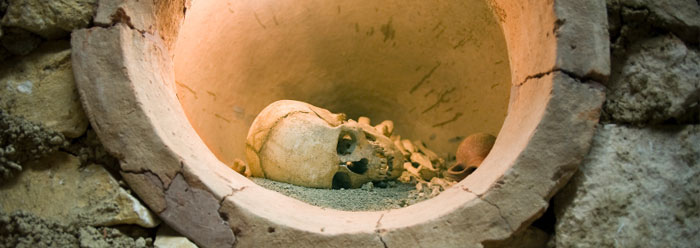In May 2010, researchers announced the completion of a draft sequence for the Neandertal genome. Provocative images of ape-like humans adorned newspaper and magazine articles, playing up the evolutionary story that humans descended from chimpanzee-like creatures. But although the scientists tried to force-fit their analyses into a man-from-ape scenario, the evidence shows something quite different.
Led by Svante Pääbo, Director of the Department of Evolutionary Genetics at the Max Planck Institute for Evolutionary Anthropology, a consortium of researchers collected decayed DNA fragments from Neandertal bone from Vindija Cave in Croatia. They then sequenced the fragments and computationally removed the vast majority of sequences, which had come from bacteria.
In 2008, they finished digitally piecing the likely Neandertal segments together, improving their inferred flaws and storing the resulting whole sequence on computers for analysis. The May 7 issue of Science presented the widely anticipated results of the comparison of the Neandertal genome to that of five modern humans, a chimpanzee, and an imaginary chimp-human DNA sequence hybrid.
In this study of the Neandertal genome, almost every step after the sequence was compiled was influenced in some way by the researchers' belief that both modern humans and Neandertal humans evolved from a chimpanzee-like ancestor. The authors considered this an unquestionable fact instead of a presupposition or bias, as revealed in this statement
We generated three-way alignments between the Neandertal, human, and chimpanzee genomes, filtering out genomic regions that may be duplicated in either humans or chimpanzees and using an inferred genome sequence of the common ancestor of humans and chimpanzees as a reference to avoid potential biases.1
The team found 78 protein-altering sequence changes that they interpreted as having arisen since modern humans' supposed divergence from Neandertals several hundred thousand years ago. They also found that only the genomes of modern Africans lacked segments of Neandertal ancestry, leading them to the conclusion that interbreeding between the two groups probably occurred after humans migrated out of Africa.2
The consortium estimated that modern humans of European or Asian ancestry inherited from one to four percent of their DNA from ancestors who interbred with Neandertals. Given the very strong evolutionary bias present in these analyses, and given the very poor quality of the starting DNA, which of these "findings" can be trusted?
Divergence "dates"--the timeframe when one group supposedly split off from another--are unreliable because they commonly change depending on which technique is used, and because blind assumptions must be used in their determination.3 But if the assumptions are wrong and Neandertals did not diverge "several hundred thousand years ago" from those who more closely resemble the modern human form, then when did they exist?
Since Neandertal remains--and perhaps all human remains, for that matter--are found in post-Flood deposits in the upper strata of the rock record, the ancient Croatians examined in this study represent a population of humans that had unique features and existed for perhaps only hundreds of years after the Flood during the Ice Age.4 The Bible and other historical sources indicate that the Flood occurred just over 4,000 years ago.
The fact that their remains are mostly found in caves fits with the hypothesis that they were a distinct migrating group, willing to shelter in caves along the way after the dispersion at the Tower of Babel. The distribution of their remains across Mediterranean areas further indicates that the Neandertal family died off before many of their descendants could migrate further away. Also, since their remains have been found in religious burial settings, alongside skillfully made artifacts,5 and in the same depositional horizon as anatomically modern humans,6 it comes as no surprise that Neandertals interbred with other human families.
Although this draft sequence of the Neandertal genome represents remarkable technical and computational achievements, doubt remains about the integrity of the raw data. There is still not consensus on which DNA base differences came from Neandertals' original DNA and which arose as a result of DNA decay after death in mitochondrial DNA samples.6 Those are much more stable over time than the genomic DNA that these scientists sequenced.7
Beyond that, the computational rigors were infused with enough evolutionary bias to make the task of teasing apart truth from fiction a daunting one. Nevertheless, there does appear to be worthwhile evidence from this genome comparison to corroborate that Neandertals interbred with other peoples--just as the creation science model would predict. Given the historical accounts of early humanity presented in the Bible, this idea should certainly not be new to the historical sciences.8
References
- Green, R. E. et al. 2010. A Draft Sequence of the Neandertal Genome. Science. 328 (5979): 710-722 (emphasis added).
- Dalton, R. 2010. Ancient DNA set to rewrite human history. Nature News. Posted on nature.com May 12, 2010, accessed May 20, 2010.
- Thomas, B. Java Man Just Got Older. ICR News. Posted on icr.org May 17, 2010, accessed May 21, 2010.
- Sherwin, F. and B. Thomas. 2010. Understanding Evidence for the Biblical Timescale. Acts & Facts. 39 (4): 16-17.
- Zilhão, J. et al. 2010. Symbolic use of marine shells and mineral pigments by Iberian Neandertals. Proceedings of the National Academy of Sciences. 107 (3): 1023-1028.
- Criswell, D. 2009. Neandertal DNA and Modern Humans. Creation Research Society Quarterly. 45 (4): 246-254.
- Zilhao, J. 2001. The Lagar Velho Child and the Fate of the Neanderthals. Athena Review. 2 (4): 33-39.
- Edwards, L. Neanderthals may have interbred with humans twice. PhysOrg. Posted on physorg.com April 21, 2010, accessed May 20, 2010.
* Mr. Thomas is Science Writer at the Institute for Creation Research.
Article posted on May 28, 2010.

















